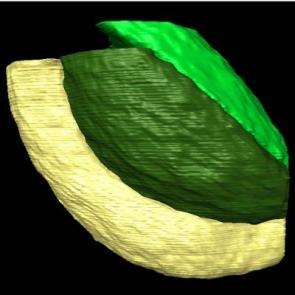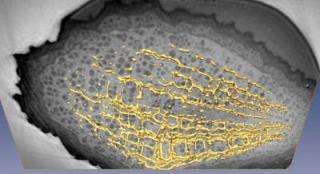Researchers watch seeds in 3D and discover an unknown air path

Researchers from the CNRS, the University J. Fourier (UJF) of Grenoble and the ESRF have recently visualised a plant seed in 3D using synchrotron light. This new view has revealed that there is a network of voids between the cells which may be used for oxygen storage that is needed for efficient germination. It is the first time that a living organism is studied using the holotomography technique at a third generation synchrotron source. The team behind the discovery publishes its results in PNAS.
Embryonic photosynthesis leads to the production of seed-internal oxygen that is important for seed development and quality. In order to visualize seed-internal structures that could serve for oxygen storage conventional microscopic methods could not be used because they require the seed to be cut thus leading to air escape. By using holotomography at the ESRF, scientists could get the full picture of an arabidopsis seed without any structural modification.
Researchers have identified individual cells within the seed and rendered them to show their three-dimensional organization. They have also distinguished an intercellular air network, which should represent an important circulation system for air and perhaps water during germination.

However, scientists can't yet assure that this is the path the oxygen follows to "feed" the seed: "Solving this question needs a nano-method to determine the exact composition of air in the network during seed formation, but unfortunately this method is not available yet", explains Silva Lerbs-Mache, the corresponding author of the paper.
The scientists used hard X-ray-based quantitative phase tomography at beamline ID19 to obtain three-dimensional images of an arabidopsis seed. This seed is a model plant for biologists and the first one the genome was sequenced. "This approach is to our knowledge the only imaging technique with the penetration capacity and imaged field size suited for an investigation at sub-micrometer resolution of an optically opaque object the size of a seed" explains Peter Cloetens, first author of the paper and scientist at the ESRF. It is applied for the first time to an autonomous living system, observed without object destruction, without staining, in air, and at room temperature.
The discovery of a void network opens the field of new research linking embryonic photosynthesis and the structure of the mature seed, in relation to seed quality, i. e. the capacity and vigour of germination. "The method could now be applied to study the seed structure of mutant plants that are deficient in germination and thus to link the mutation of one gene to changes in seed structure", explains Silva Lerbs-Mache.
Source: European Synchrotron Radiation Facility















